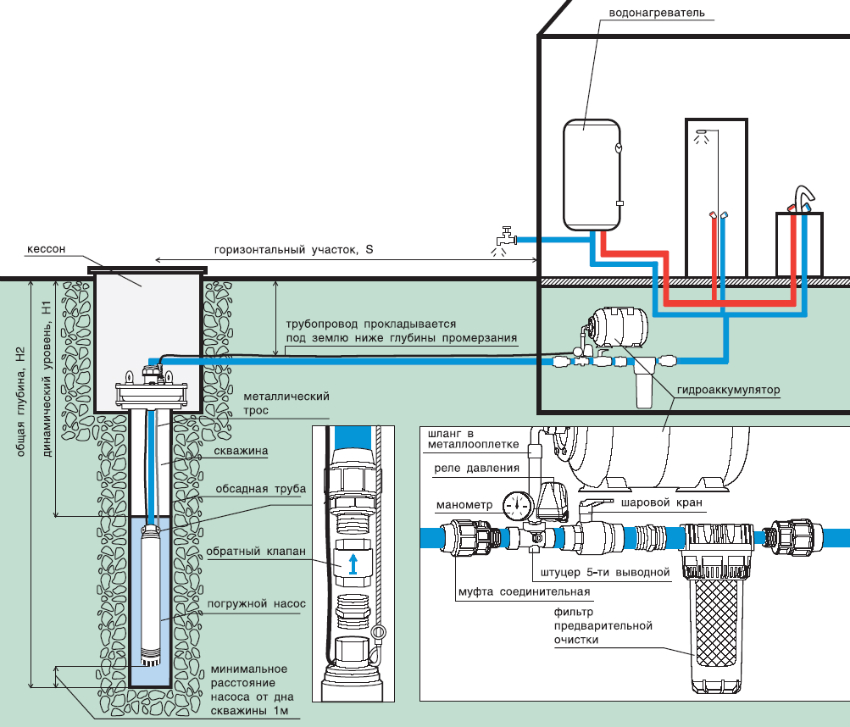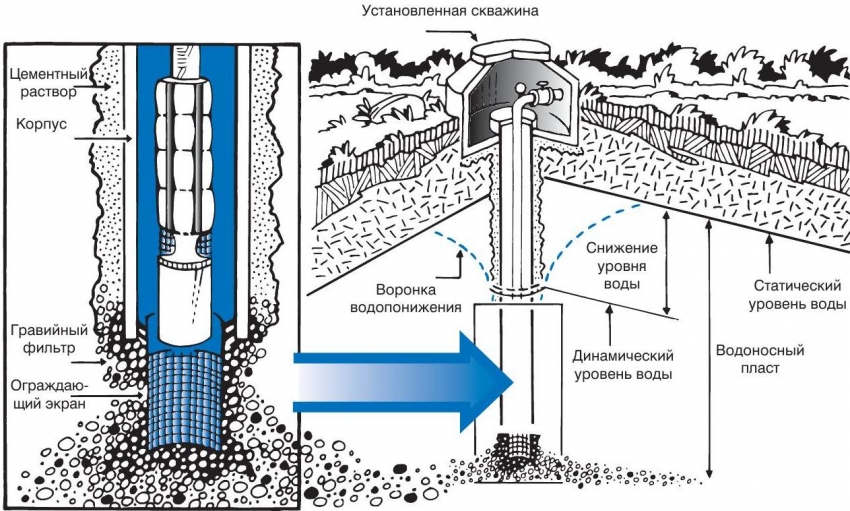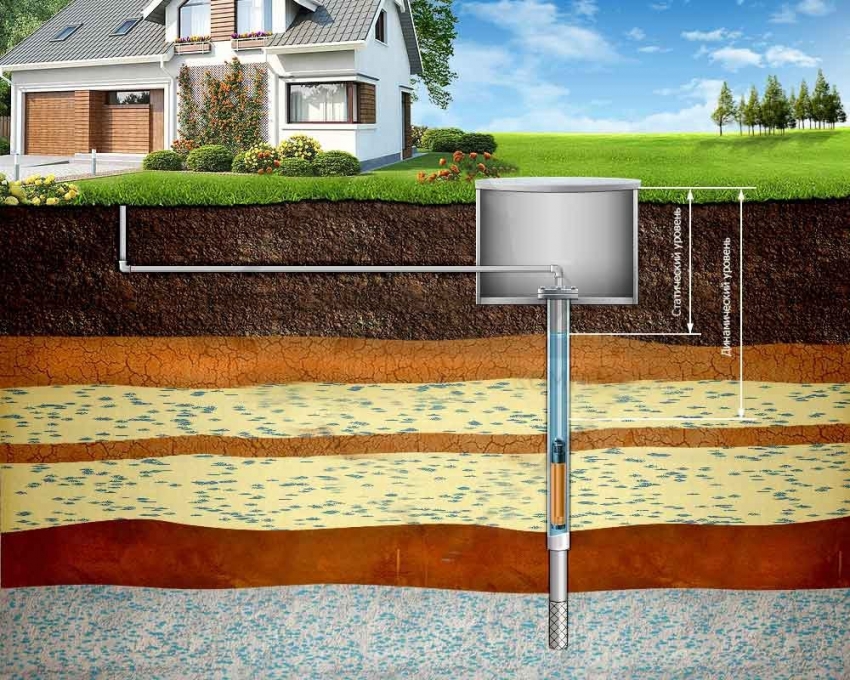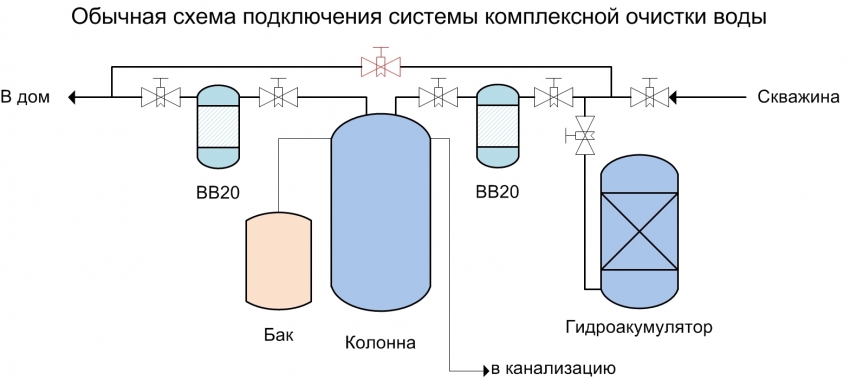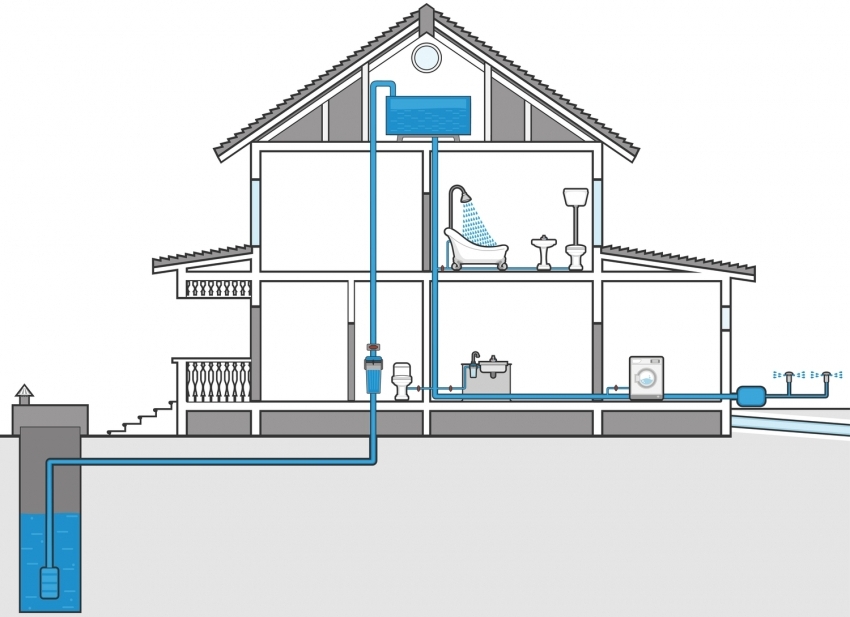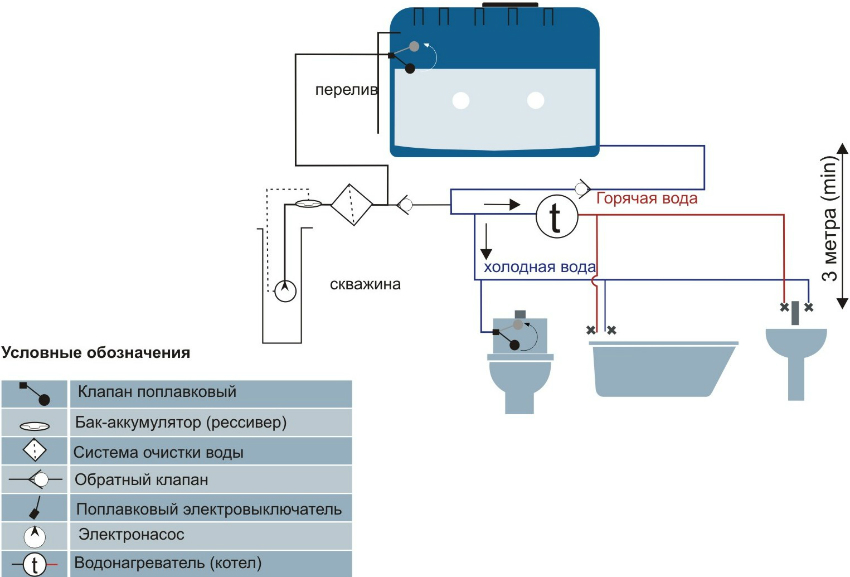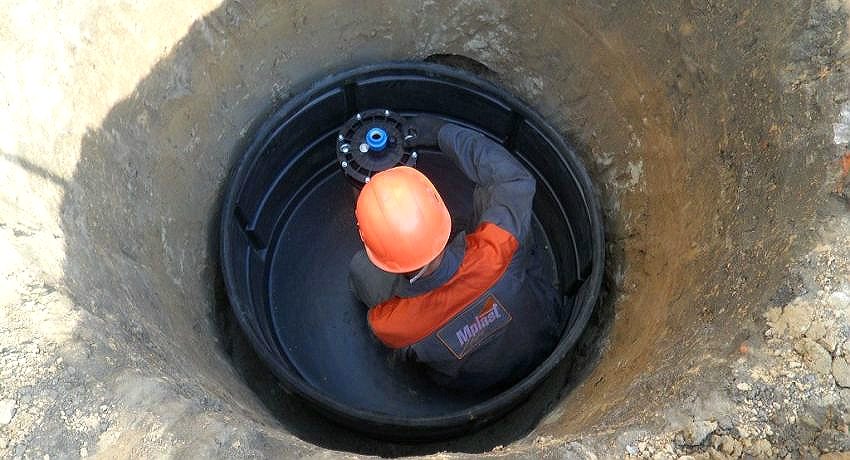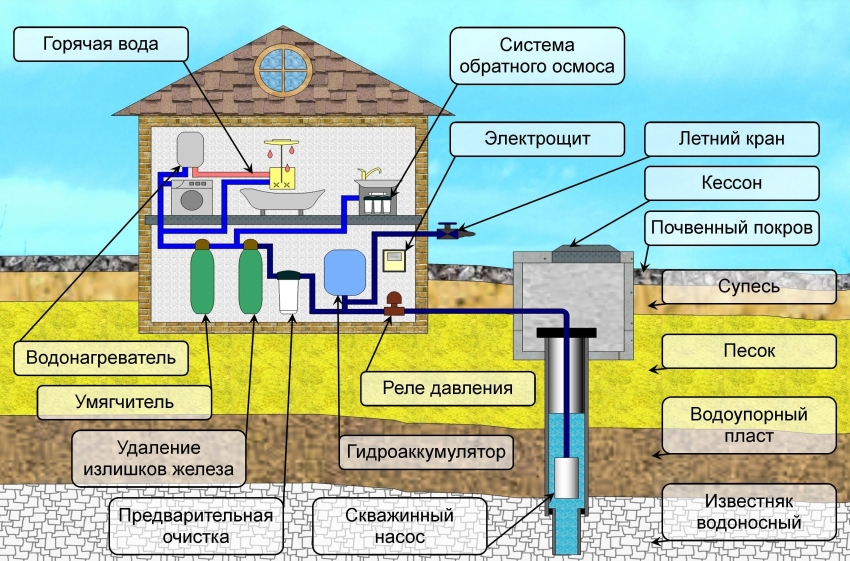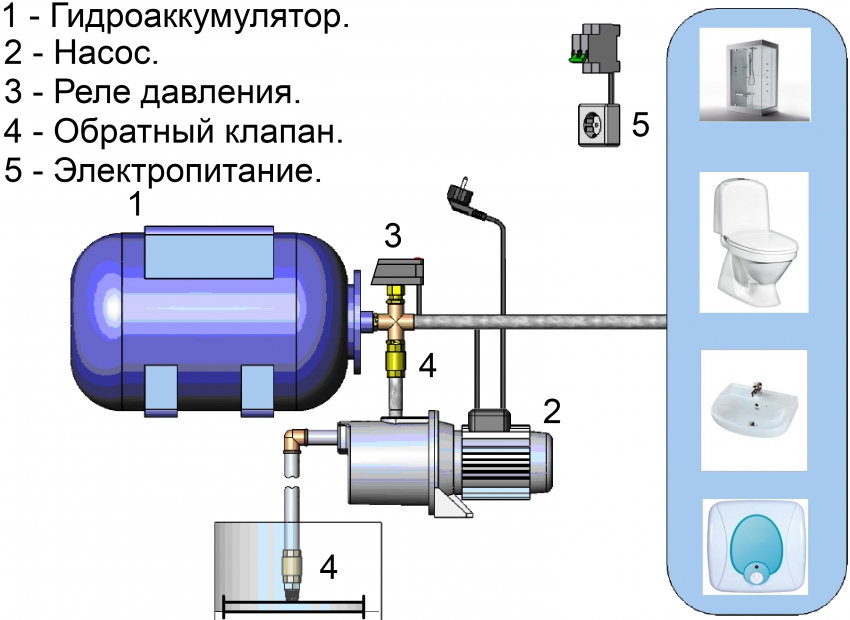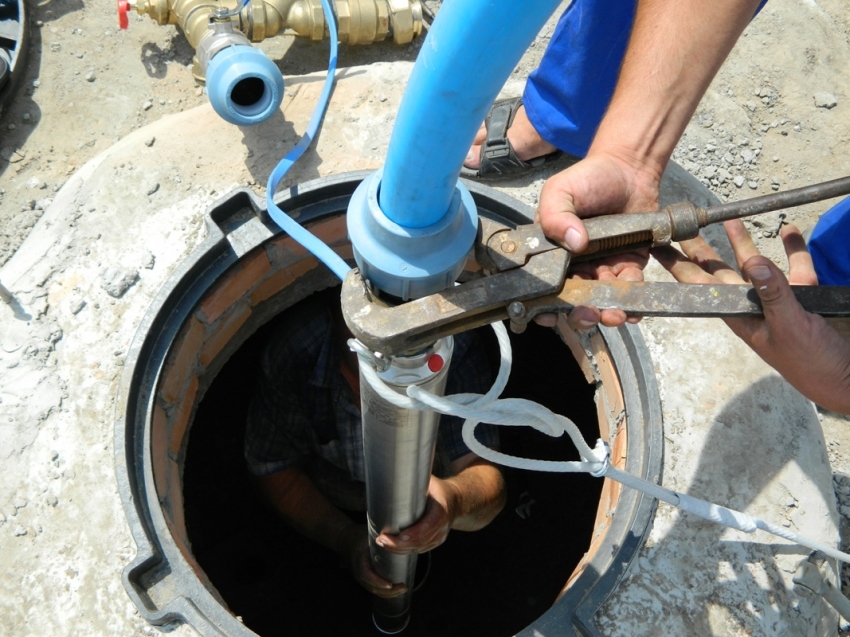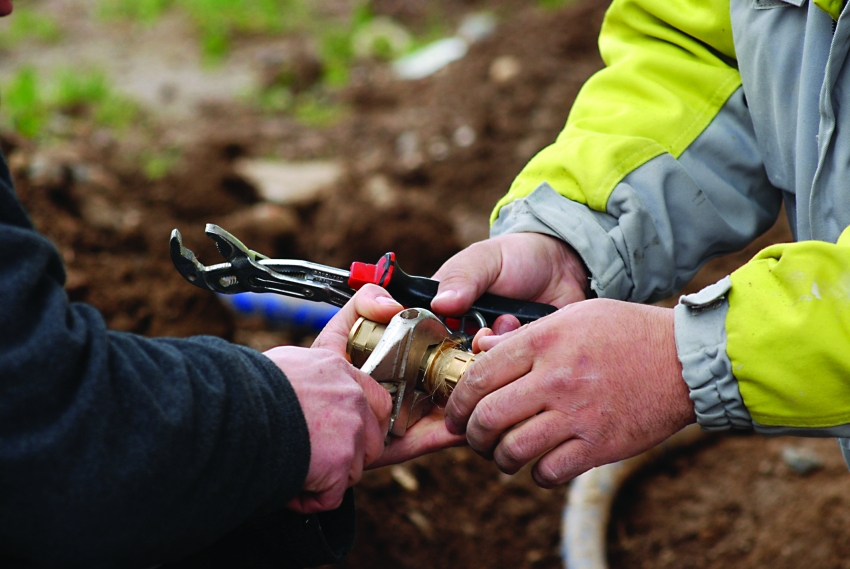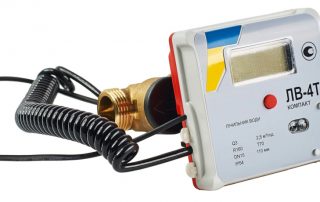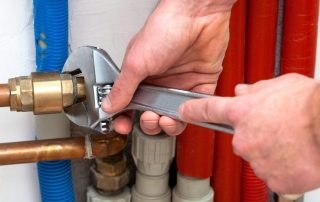From this article, you can find out how the water supply of a private house from a well looks from the side: a diagram of a tower and two-stage type system, as well as communications with a pumping station, stages of building a water source, laying a pipeline on the site and connecting all elements. The text deals with the features of the technology, the rules for the selection of equipment and its installation.
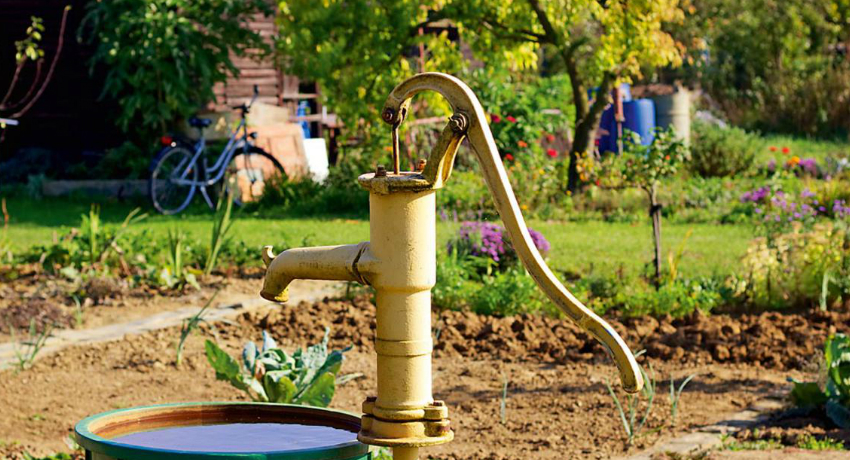
Using a well is the best option for carrying water to a private house if there is no centralized water supply
Content [Hide]
- 1 Water supply of a private house from a well: system diagram for a private house
- 1.1 What factors to take into account when developing a scheme for a water well
- 1.2 Advantages and disadvantages of a typical water supply scheme for a private house from a well
- 1.3 Features of the tower water supply scheme in a private house from a well
- 1.4 Diagram of a well for water in a private house with a pump and a two-stage supply
- 2 Technology for arranging the water supply system of a private house from a well
Water supply of a private house from a well: system diagram for a private house
Conveniences in suburban areas are provided due to a decentralized water source. In theory, the technology for arranging the system is quite simple and involves the formation wells, installation of a caisson, installation of a pipeline and a storage tank. By combining all these elements together, and connecting automatic equipment, you can supply water to the country house and provide comfortable conditions for people to live there permanently. Each of the listed stages of construction has its own nuances and subtleties, which should be familiarized with before starting work.
Well use is accompanied by certain features that distinguish this system from well:
- Water is taken from several horizons. For these purposes, can be used verkhovodka, as well as artesian and sand levels.
- The wellhead is reliably sealed, because the hole of the well is much smaller in size than the well shaft.
- Since water is taken from a house through a well from a great depth, there is a need to install volatile equipment, as well as a backup generator in case of power outages.
The system will also require the installation of a caisson. This element is placed at the mouth. It is a pit, the depth of which is 1.5-2.5 m. The caisson is used to place equipment and cut in a line under pressure, which is laid below the level of winter soil freezing.
What factors to take into account when developing a scheme for a water well
Before starting work on the organization of a water supply system powered by a well, it is imperative to draw up a preliminary diagram. This will make it possible to indicate the direction in which the construction will go, divide this process into stages, and study in detail the nuances and difficulties of implementing each of them. Purification equipment will help improve the quality of water. In most cases, for a summer cottage, it will be enough to install fine and coarse filters.
Note! When it comes to purchasing special equipment for iron removal or water softening, this will require laboratory analysis of a sample from a well and the help of specialists. Otherwise, the purchase can turn into a waste of money.
If you work independently on the development of a water supply scheme in a private house, you need to take into account the main parameters of the site and the system:
- the depth of placement of the aquifer in the soil;
- the area where groundwater is located;
- markings and indicators of materials used for construction;
- dimensional parameters of structures and system elements;
- dimensions and nature of the caisson placement;
- the point where the well will be formed;
- characteristics of the underground source;
- operating conditions at the site;
- mode of water consumption by residents.
The maximum working resource, which is typical for artesian wells - up to 50 years. At the same time, filtration of the liquid is practically not required, since the water does not have impurities that can damage the pumping equipment. The layout of the pipeline is selected taking into account the volume of daily water consumption and the flow rate of the source. This is necessary so that residents can operate the system without restrictions during peak hours.
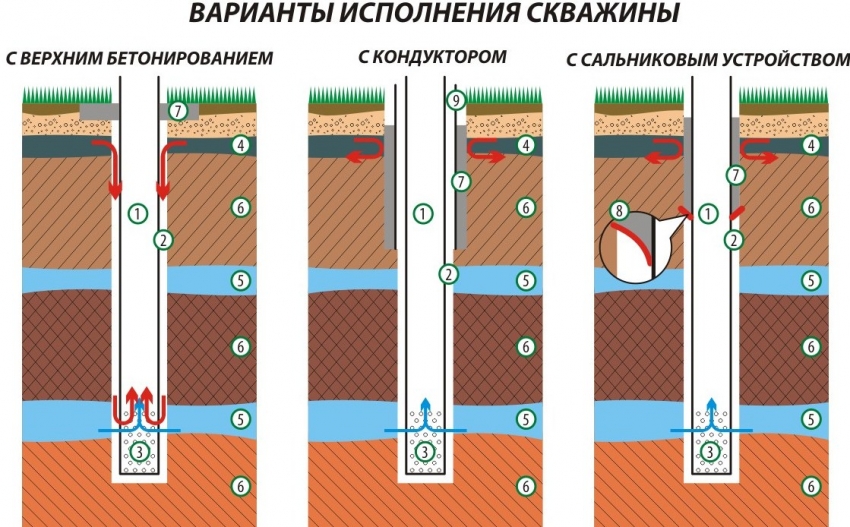
1. Production casing, 2. Annular space, 3. Filter section of the casing, 4. "Verkhovodka", 5. Aquifers, 6. Impervious strata (dense clays), 7. Cement filling, 8. Packing device, 9. Blind steel column (conductor)
The possibility of placing both outside the building and inside it distinguishes well from the well. The source can go underground or on the ground floor. As a result, the maintenance system is greatly simplified, and it is also possible to reduce the cost of laying a water supply system. Home communications have an extremely simple structure. The system assumes the presence of a well, inside or on its surface, a pumping station is installed that transports water to points of consumption.
Helpful advice! If the house is used for temporary residence, it is necessary to organize a winter water supply system on the site, where the internal circuits will be emptied when heating is not used.
Advantages and disadvantages of a typical water supply scheme for a private house from a well
So that there are no difficulties in the further operation of the water supply system, it is necessary to foresee in advance the options for solving the problems characteristic of these communications.
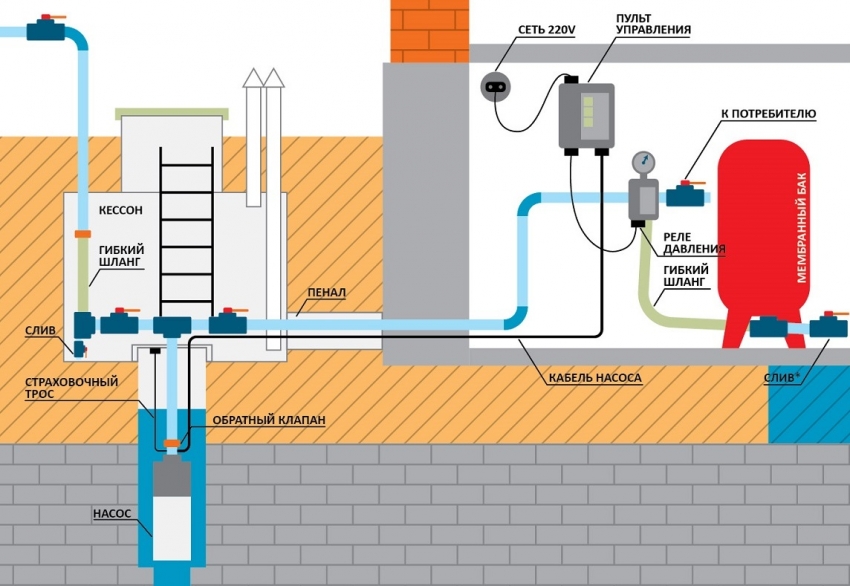
Typical diagram of a water supply system using a well, a pumping station and an automatic water supply system
Uninterrupted operation of the system at each opening of the tap is possible only if a stable water pressure is maintained in the pipes. For this, the pumping equipment must work constantly, as a result of which the unit wears out quickly. For this reason, you should buy high-quality stations that are designed for high loads.
There is a possibility that the water supply will be cut off during a power outage. In this case, you need to provide an alternative solution to the problem or a way to create an additional supply of fluid.
The operation of the pump is accompanied by other difficulties.The unit must be powerful enough to provide water to several consumers at once. In addition, the equipment needs to be placed somewhere, so you will have to allocate space for its installation.
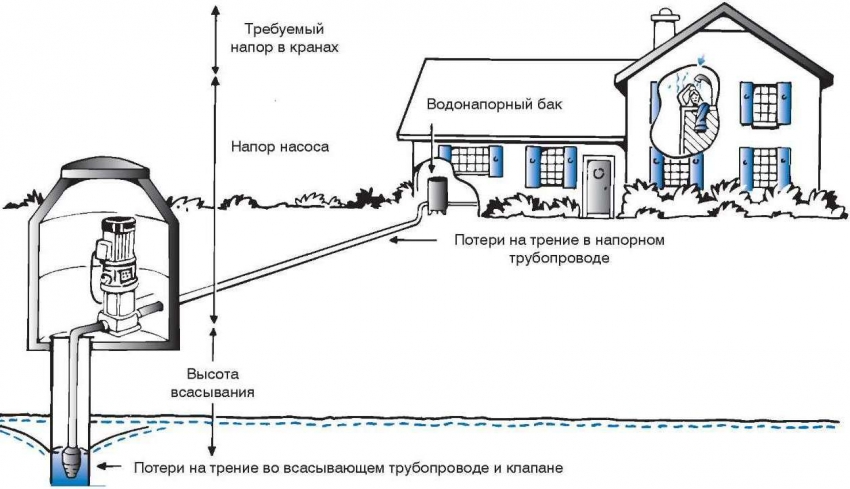
When installing a submersible pump for a well, it is necessary to take into account the factors affecting the design head
In view of the above, to enter water into a house from a well, you will need:
- A source of water.
- Surface or submersible pump with centrifugal action.
- Caisson for pipeline tie-in.
- A non-return valve that prevents backflow of water when the pump is off.
- Expansion tank in the form of a hydraulic accumulator equipped with internal membranes.
- Filtration equipment to maintain water quality.
- Automatic system for monitoring the presence of water in pumping equipment.
If the construction budget is limited, you can use the storage tank, which is located at the highest point of the house. For these purposes, an attic or attic space is suitable. But the best option would be a pumping station in combination with a hydraulic accumulator.
Helpful advice! For difficult operating conditions, it is better to choose a two-stage scheme. It will ensure uninterrupted operation of the system if the well is located far from a residential building, its depth exceeds 50 m, or the productivity does not cover the needs of residents during peak hours.
Features of the tower water supply scheme in a private house from a well
Tower water supply in a private house involves the placement of a storage tank in the attic. This is where the pump draws water to cover the needs of consumers during peak hours. According to this scheme, water moves through the system to the points of consumption by gravity.
For tower water supply, an expansion tank is a mandatory element. It can be of the simplest design or additionally equipped with a float switch.
The principle of operation of the switch is as follows:
- When the storage tank is full, the pump turns off.
- As residents use up water, the liquid level in the reservoir decreases.
- When the water level reaches a certain level, the float is triggered and starts the pump to replenish the spent supplies.
This option for arranging communications is considered the most budgetary, easy to maintain and reliable. The possibility of water hammer is excluded.
The scheme also has disadvantages:
- to install the tank, you will need to take up free space in the attic, which could be used for other needs;
- the pressure in the internal water supply systems will be unstable, therefore, the pressure in the taps may disappear;
- the load on the supporting structures of the building increases;
- the system needs insulation.
Diagram of a well for water in a private house with a pump and a two-stage supply
The most convenient option to operate is a system using a pumping station. On sale you can find many devices designed to equip an autonomous water supply to a country house using centrifugal submersible units or vibration devices.
Related article:
Plastic caisson for a well: how to choose and install yourself
How to choose and install a suitable tank yourself. Appointment of the caisson. Prices and characteristics of the most popular models.
Schemes of such communications, in addition to standard elements, include:
- dry running sensor;
- relay;
- hydroaccumulator.
The main component of the system is a station equipped with a pump that is installed on the surface.
This arrangement is very convenient as it offers an effective solution to the problem when the pressure in the discharge line is decreasing. When the tap is opened, a drop in indicators in the system is fixed by a relay. It is triggered by pumping fluid into the accumulator. When the reservoir is full, the inner diaphragm expands and the pump is shut off.
After completing the above steps, the pressure in the hot and cold water supply system is independently equalized. If the pumping station does not have a sufficient power level to provide all consumers with liquid during peak hours, it is recommended to use a two-stage water supply scheme in a private house with additional equipment.
Note! The high performance of the pumping station is not always an advantage. This indicator should not exceed the debit of the water source. Otherwise, the effect of "dry running" appears and the parts of the equipment will be subject to strong wear.
In a two-stage system, the reservoir is mounted immediately after the pump. The volume of this container varies between 500-1000 liters. The tank is equipped with a float switch. You will also need additional pumping equipment to pump fluid into the system. It connects to the storage tank. Next in line is the installation of a hydraulic accumulator and pipeline to consumption points.
Technology for arranging the water supply system of a private house from a well
To work, you will need to calculate the amount of daily water consumption. Based on these data, a scheme for construction is selected, the diameter of pipes is selected, as well as the characteristics of pumping equipment.
How to bring water into the house from a well:
- Equip the source by drilling a well and installing a casing.
- Install a caisson, the upper part of which is covered with a hatch or masked with a decorative house.
- Install pumping and filtering equipment.
- Lay a pressure line between the well and the residential building.
- Connect the water supply to the source by cutting the line into the caisson using fittings.
How to conduct water from a well to a house: arrangement of a source
The well is being developed on a personal plot. The recommended depth of the source is in the range of 25-50 m. For the construction of deeper wells, it is necessary to take a special permit, and significant financial costs will also be required. After the drilling work is completed, the installation of a casing pipe with a diameter of 10-15 cm is carried out. Its upper end should rise above ground level.
If the groundwater is deeper than 2 m from the surface of the earth, well... In other cases, it is more expedient to stop at the construction of a closed type insulated extension. This will allow the system to be serviced all year round. The size of any of these structures must be sufficient to clean the well and repair the pumping station.
To make a house for a well, you can use bricks or cinder blocks. It is allowed to use a wooden beam for the construction of the frame. The room is insulated along the entire perimeter, including the ceiling base and floor.
Helpful advice!It is better to use polystyrene foam plates as a heater. The minimum material thickness should be 10 cm.
The algorithm for the construction of a brick house for a well in the water supply system of a private house looks like this:
- Marking around the source.
- Trenching.
- Installation of formwork structures.
- Laying a shallow strip-type foundation on the drainage layer.
- Exposure of the foundation under the film for 7 days.
- Waterproofing works.
- Formation of walls using brickwork.
- Installation of boards and construction of a gable roof.
The water in the supply pipe must not be allowed to freeze when temperatures are low outside. For this, a heating cable is used. It needs to be wrapped around the supply pipe. It is also not recommended that surface water enter the source. Raising a pipe above ground level for supplying water to a house from a well completely solves this problem. The element of the system is lifted by about 40 cm. To prevent the ingress of dust and debris, the pipe should be closed with a cap.
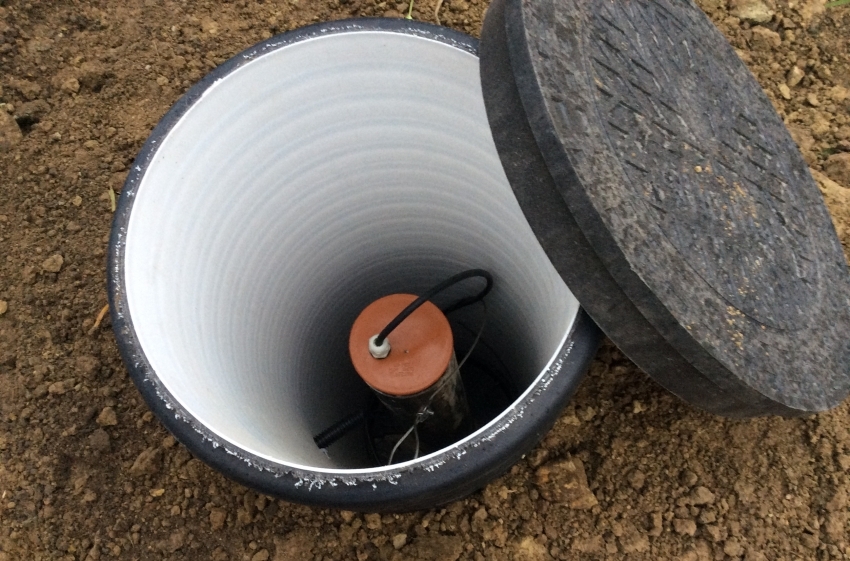
An important stage in bringing water into the house from the well is the arrangement of the caisson, its insulation and insulation
If the groundwater is deep, the well is hidden in a well. The deeper the structure, the higher the temperature in it in winter. The structure is insulated in the same way, and a heating cable is wound around the pipe.
Highway for the water supply system of a private house
When installing the water main, it should be remembered that the pipes should be located below the level of soil freezing. Otherwise, all elements of the water supply system in a private house will be negatively affected by temperatures and will soon completely fail. First, according to the developed scheme, trenches are dug at the site of the required depth. Pipes with a diameter of 32 mm are laid at the bottom.
For the construction of the highway, pipes made of cross-linked polyethylene or metal-plastic are suitable. Experts allow the use of HDPE pipes, but do not recommend doing this, since the material is sensitive to low temperatures and is subject to destruction. Also, do not use hoses to supply water to the house from the well. They are not suitable for transporting liquids in this way. Even those pipes that run below the freezing point of the soil can be frozen in the lifting zones.
The problem with freezing pipes is solved in several ways:
- insulation of the foundation part of the building;
- wrapping the pipe with a material with thermal insulation properties;
- installation along the trunk of a self-regulating heating cable.
If the site does not have the conditions for carrying out earthworks, then the line for the water supply device in a private house from a well can be laid on top, only slightly burying the pipes into the ground. The use of a self-regulating heating cable is mandatory in this case.
Note! During the laying of the pipeline, the cable is also installed, which is responsible for powering the pumping equipment. The ROM box must be placed in a specially designated heated room. The recommended cross-section of a four-core electrical wire is 2.5 mm or more.
Energoflex and other similar materials can be used as additional insulation for the surface system. To improve the thermal insulation properties of the cake, it is placed in a larger diameter pipe. It can be sewer or corrugated. Also, a storage tank is installed in the system, designed for watering plants with warm water.
Selection and installation of pumping equipment for water supply of a country house
The operation of the water supply system is based on pumping equipment. For these purposes, two types of units are used: centrifugal and submersible rotor type. In most cases, the owners of summer cottages give preference to a submersible submersible pump operating on the rotor principle.
When buying equipment, you need to pay attention to the following parameters:
- source depth;
- maximum amount of water consumption;
- the minimum size of the water column;
- total fluid consumption.

The choice of equipment for the water supply system depends on the level of needs of the residents of the house and the frequency of its use.
In addition, the technical indicators of the pumps are taken into account. The most important of these is pressure. This indicator displays the level of pressure created by the vanes that is used to push the liquid. This information is indicated by the manufacturer in the documentation and is displayed in meters. The second important indicator is the pump flow rate (m³ / h). It displays the volume of water that the pump is able to move in a certain unit of time.
These indicators affect the level of electricity consumption. The higher the value of these technical characteristics, the more electricity consumption will be during the operation of the equipment. If the flow rate increases, the water pressure decreases.
Helpful advice!FROMby minimizing losses in the water mains, you can optimize the operation of the equipment. As a result, the possibility of overloading is eliminated.
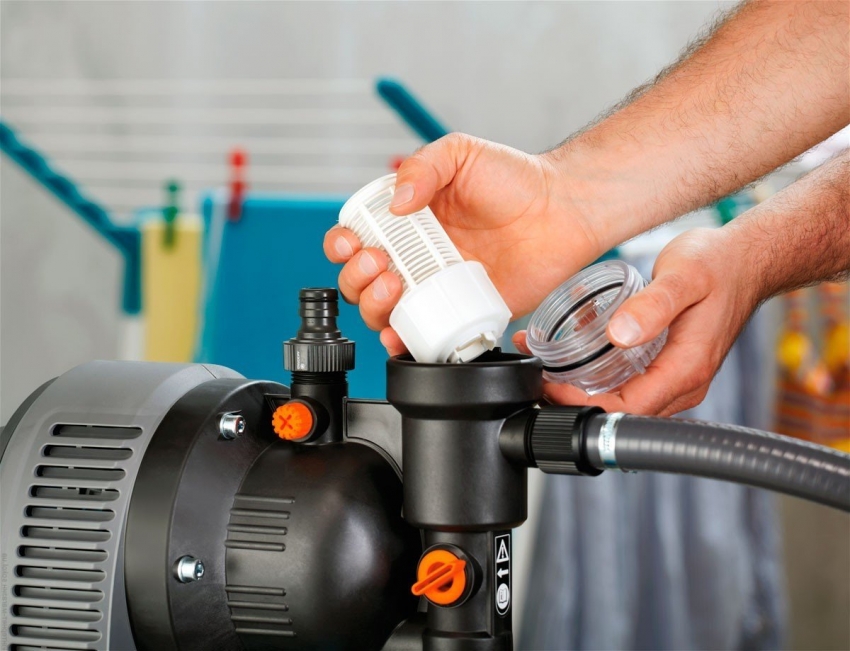
When choosing equipment for a water supply system, special attention should be paid to the issue of high-quality water filtration
Most often, buyers select pumps for water supply systems in a private house with a pressure of 60-80 m. The average consumption of such units is 4 m³ / h. If there are regular power outages or power surges, a stabilizer should be connected to the pump.
The equipment is lowered into the well using a wire rope. The distance from the pump to the bottom is 1-3 m (depending on the system and conditions). If the equipment does not have a check valve, this element must be installed. Before fixing the cable and lowering the pump, a HDPE pipe with a diameter of 32 mm is attached to it.
Then the lower part of the head with an elastic band for sealing is put on the well pipe. After that, the pump is slowly lowered into the well, while every 1.5 m a heating cable is fixed to the pipe, avoiding strong stretching. The pump should be lowered to the very bottom, and then raised to the desired height. All that remains is to fix the equipment and fix the upper part of the head to the pipe.
Having considered the mechanism for arranging the water supply system, one can come to the conclusion that the system for transporting water from the well to the house can be organized with your own hands. The main thing is to take into account all the nuances and requirements of the technology. With a lack of knowledge and skills, this work can be entrusted to specialists. Construction in this case will be faster and of better quality, but it will cost much more.
